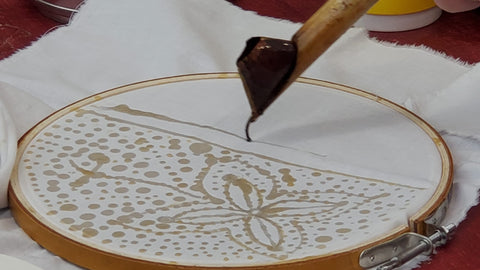From the minimal style block print of a coffee bean motif to the intricacies of Pekalongan, the process of creating a batik piece can range from a month to two years depending on the complexity of the design and colour combinations used in the making of the traditional textile.

With the industrialization of batik, machine-made versions of this traditional fabric can be found right alongside those who continue to engage in this ancient art of storytelling by hand. While different batik motifs can include many additional steps in its production, there are two processes that are consistent in the fabric making of every batik piece: wax patterning and colouring.
Canting

Batik tulis, or "handwritten" batik, is designed using a canting. This pen-like tool features a wooden handle, a copper container that holds the wax which connects to a copper spout that is used to draw the motif. Using a heated blend of plant resins and paraffin, the artisan then draws the design following the motif previously drawn in pencil. For larger patterns, a stiff brush may also be used to produce batik lukis or "painted batik.
Check out the hand-drawn details of the Mriwis hairband in a special collaboration between The Batik Library and Hair of the Dog, which tells the magical story of the wandering whistling duck.
Cap

In the mid-19th century, a stamping technique was invented to meet a higher demand of batik. Batik cap or "stamped" batik offers the same detailed quality of a motif in the form of a bronze block filled with melted wax. For artisans, this technique is highly preferable for batik pieces that require geometrical patterns or repetitive designs such as the illustrious Parang motif that was once reserved for the courts of the Majapahit empire. Once the wax is melted in the range of 60-70 degrees celsius, the cap is dipped into a wax bowl and excessive drops of the liquid wax are removed before placing it on the linen.
Check out the cap technique in The Batik Library's gender-neutral short-sleeved top featuring a Parang motif in the colour coklat.

Nyelup
After the design has been created through either the tulis, lukis or ngecap process, the fabric is soaked into a barrel filled with dye. The Batik Library uses natural dyes like ketapang and indigo making it safer for you, the environment, and the artisans who create our one-of-a-kind pieces. Depending on the complexity of the design, the soaking process may vary from a few days to a few months. Once the dying process is completed, artisans will often outline and add detail and clarity to the pattern.
Check out the Tanahan dua pattern from The Batik Library's Tanahan Collection, which were dip-dyed up to 22 times to achieve its deep shade of indigo.

Nglorod
To reveal the batik motifs from the wax resistance, the fabric soaks in a boiling bath of water and sodium carbonate. Because artisans aim to remove all the wax from the fabric, which varies in thickness, it can take days to complete this process. Once free of all malam or wax, the fabric is bathed in cold water and sometimes given a finish.
Ngejemur
This intensive process comes to an end with its final ritual: ngejemur or hang drying - another process that can take days to complete depending on the weather. It's essential that the fabric is places away from direct sunlight to avoid being bleached. Once dried, the batik is stored in a dry, cool place.




